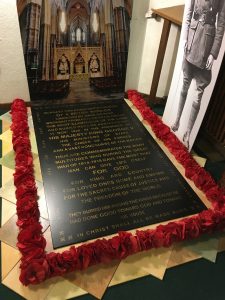The Unknown Warrior

The Revd. David Railton was curate at St Mary and St Eanswythe’s church from 1914 to 1920. He was given leave of absence to serve as a chaplain on the Western Front and did so with distinction, being awarded the Military Cross in 1916 for saving an officer and two men under heavy fire.
One evening, as he returned from conducting a service for a fallen friend in Armetieres, he passed a small garden in the corner of which was a grave marked by a simple wooden cross. Written on it, in pencil, were the words “An Unknown British Soldier on the Black Watch”. Railton was greatly moved, later writing “How that grave caused me to think!… But, who was he, and who were they [his folk]?… Was he just a laddie… . There was no answer to those questions, nor has there ever been yet. So I thought and thought and wrestled in thought. What can I do to ease the pain of father, mother, brother, sister, sweetheart, wife and friend? Quietly and gradually there came out of the mist of thought this answer clear and strong, ‘Let this body – this symbol of him – be carried reverently over the sea to his native land’. And I was happy for about five or ten minutes.”
During the war he wrote to General Haig to suggest that an anonymous solder be buried with full military honours as a memorial to the unknown dead, and although his idea was not taken up at the time he did not let it die. In 1920, now Rector of St John the Baptist, Margate, he wrote to the Dean of Westminster, Rt Revd Herbert Ryle, suggesting that the unknown soldier should be buried in Westminster Abbey. Ryle’s support, together with that of Lloyd George, brought the project to fruition and an unknown soldier’s body was interred in the Tomb of the Unknown Warrior on the second anniversary of the end of World War I.
The Friends of St Mary and St Eanswythe mounted an exhibition about Rev Railton and the Unknown Warrior at Folkestone Museum. Unfortunately because of lockdowns the exhibition could only be visited for short periods. Many of the artefacts from the exhibition, including the replica of the Tomb of the Unknown Warrior, will be on permanent display in the Church. The replica is already on temporary display, pending permission from the Diocese for the permanent display to be installed.

A leaflet about the exhibition is available here: Unknown Warrior Leaflet.
Westminster Abbey have a comprehensive account of the Unknown Warrior, including the burial service, and other services of remembrance connected with the Unknown Warrior, here.
